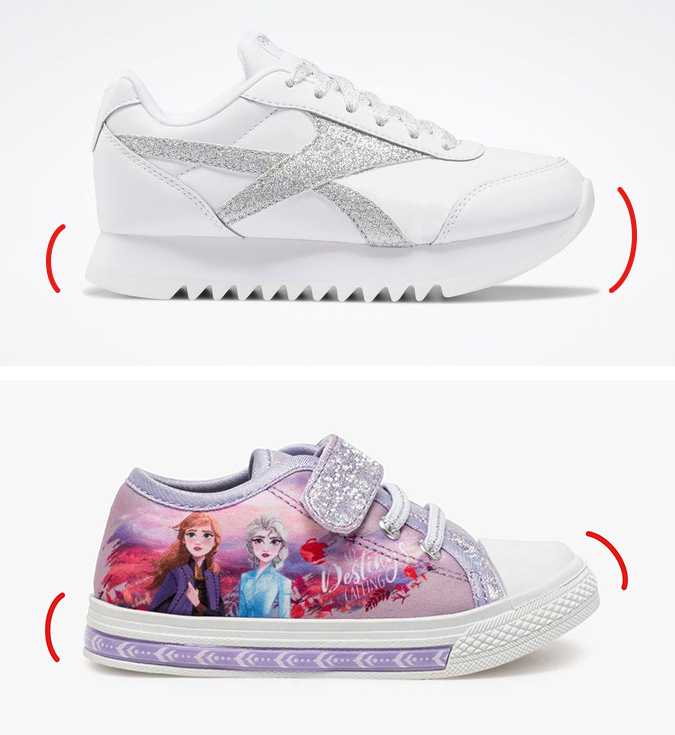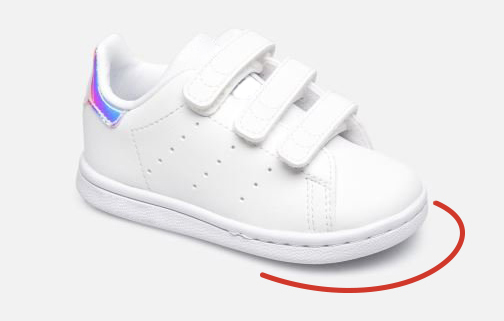To answer this question, you have to know what you are buying and that is the hardest part! It is the metaphor of the tree that hides the forest...

We have sifted through 4 themes: materials, ethics, design, promotions to try to make sense of what's behind a label.
We won't talk about the cost and labor regulations here. If you are interested in the subject, we talk about it in detail in the article about our production in Portugal.
THE COST OF (GOOD) MATERIALS
The materials used inevitably impact the final price of the shoe you are going to buy. However, it is quite difficult to understand what you are buying, as there are so many components. In addition, there is no standard, no classification ... it is very complicated to see clearly.
Here is a small table that shows the differences that we generally notice and that are not always visible to the touch, to the sight (or to the smell!) when we compare two children's shoes in our hands.

Economically speaking, there is no better or worse. There is just a quality-price ratio to evaluate. The difficulty remains to see clearly and to avoid the most common traps:
Leather :
- Some manufacturers indicate "leather" on their shoes when only the insole or a detail of the product is leather. This is a form of deception if one hopes to benefit from the natural breathable and insulating properties of leather.
- There are many levels of Leather quality on the market. This is determined by the raw material and the tanning. the LWG (Leather Working Group) certification is a good guarantee of quality control of Leather tanning even if it is not perfect...it is also the only one.
Textiles :
- Synthetic materials perfectly copy the visual aspect of cotton. But with use, one quickly realizes the difference, in particular with perspiration.
- Cotton comes in different qualities: recycled and/or organic cotton is more expensive but more interesting from an environmental point of view because it consumes fewer resources (water and reuse of used materials).
Wool :
- Some synthetic materials copy virgin wool very well. It is only when you use it: comfort, perspiration, flexibility, durability, that you realize the difference but the purchase is already made.
THE COST OF ETHICS
Low-cost brands are based on a business model that aims first and foremost to lower costs as much as possible. This has a strong impact on the environment in a broad sense and creates a lot of collateral damage. What is unfair is that this damage is borne by society as a whole, including customers, and not by the company that created it.
Thus, low-cost brands have a competitive advantage that is impossible to fight against. In order to offer low prices, they "damage" but they do not pay the consequences. They "break" for free in a way... On the contrary, wanting to make an ethical shoe brand has a cost. In a way, we pay for less "damage".
Here is a small table that shows the concrete differences.

THE COST OF DESIGN
Developing a shoe specifically for children is a significant investment for brands. It is easier and less expensive to miniaturize an adult model. This is due to the shoe itself but also to the range structures.
Children's shoes require major ergonomic and structural adaptations specific to their age:
- Ergonomics: velcro, removable sole, side zip, comfort at the back of the heel, reinforcement at the front ...
- Structure: thickness of the sole, flexibility to unroll the foot, heel support...
Moreover, the composition of children's ranges is very expensive because the volumes are broken down into a large number of sizes. Let's take the example of the purchase of 100 pairs of shoes by a brand :
- the women's model is divided into 7 sizes from 36 to 42, i.e. 14 pairs per size.
- the child model from 22 to 36, is divided into 15 sizes. That is to say 6 to the size, 2 times less!
Now, we make savings when we produce few references in very large quantities ...
Specialist in children's shoes: necessary but increasingly rare.
As a parent, when we started the adventure, we were struck by the fact that many so-called "children's shoes" were actually replicas of adult shoes in miniature. We find that some parents no longer see the point of buying specialized shoes for children.
However, common sense shows us that an adult shoe and a child shoe are very different. From experience, these points seem important to us:
- The shape of a child's foot is different from that of an adult
- The child's foot is constantly growing
- The child's entire posture is affected by his or her shoes
- Bad postural habits are formed in childhood

The latest chic
Europe has finally turned its back on its culture of quality footwear
Europe has long since abandoned its shoe production capacity, now accounting for only 3.6% of world production, compared to 86.3% for Asia alone (source: World Footwear 2018 Yearbook)
This profound change in production has not only affected the industrialization of Europe, but also the footwear consumption habits of Europeans.
Adults moved from a locally produced leather shoe to a synthetic sports sneaker produced in Asia. Children have followed the trend, reducing the shoe to a fashion accessory, a sports sneaker or a plastic slipper. In short, no longer a matter for specialists...
Things could change again thanks to adults. Adults want to consume quality sneakers. Leather sneakers, eco-sourced, will this European quality culture come back? This remains a niche today.
Why are adult brands miniaturizing their shoes?
If you want to launch your own shoe brand tomorrow, the best advice we can give you is: make a brand for women or men :-)
That's what most new brands do, then, once the product is installed, they miniaturize it and launch the children's range.
Our factory in Lousada, Portugal is specialized in children's shoes, but also has a line dedicated to adults. The difference in cost between a leather sneaker in size 25 and one in 45 is about 8 €. However, at the sale (for this level of quality of course), the child sneaker will be sold for 89 or 99 against 199 for the adult. And much more at some brands.
According to Frédéric Godart, fashion historian and sociologist, quoted in an article in the Nouvel Observateur in France, brands invest in children's fashion primarily for commercial reasons: "The problem in the fashion and luxury sector is that the market is slowing down. After the development of adult fashion, brands have to find new customers to conquer, new sectors to explore... And that only leaves children!"
The interest of the child before the seduction of the gadget
For us, being a specialist means above all guaranteeing the parent that the child's interest will always be the one that takes precedence. Here is an anthology of what we won't do at Benjie:
- Create a gimmick to appeal to the child at the expense of their comfort or foot development. Marketing to children is very pernicious and often works against their interests... This is the example of the sole with lights or with wheels. the lights and the wheels imply to stiffen the sole and to thicken it. Two ideas that go against the principle of flexibility and lightness that are crucial to allow the child to strengthen his arch.

Very strong: lights AND wheels, yeah!

- Giving in to an adult fashion artifice to the detriment of the comfort or development of the child's foot. This is the example of a wedge sole or a raised heel. It is already uncomfortable and deforming for an adult foot, so for the foot of a child in training ... In addition, a thick sole moves the foot away from the ground, so it does not promote the work of balance and proprioception that develop the deep muscles.
- Reproduce an adult model in miniature. This is the case with many sports brands. The consequence is often a very wide sole, very slippery ... because a shoe is not as beautiful from 22 to 46. Children walk like penguins and do not roll their foot naturally. We could also talk about the weight of the shoe: some shoes for walking in the snow for example weigh tons. They are just replicas of miniaturized adult models.

THE COST (AND ILLUSION) OF PERMANENT PROMOTIONS
Since November 1995, sales are no longer regulated in Switzerland. In 25 years, the number of products on sale has exploded giving sometimes the impression that some shops are on permanent sale.
At Benjie we have decided to make sales by staying focused on common sense. That's how:
- We try to offer a fair price all the time by Working always better our quality / price ratio so that all our customers can enjoy it all year long
- We make sales during the periods of sales (end of seasons) to sell our unsold goods. This is the basic principle: no disguised promotion, but a boost to sell models with many pairs left in stock
- We don't do any special promotion during the year, no black friday or other principle based on stocks bought to be destocked!
- We are looking for solidarity mechanisms for the sales, by offering pairs of shoes to the Vestiaire Social de Caritas / CSP (Centre Social Protestant) for example. The idea is to dispose of the stock in a responsible way, even if it means giving it to those who need it to avoid throwing it away.


There is something to be puzzled by when faced with certain sales
BUYING A QUALITY CHILDREN'S SHOE WHILE ITS USE IS LIMITED IS A GOOD INVESTMENT FOR YOUR CHILD.
The reason there are so many poor quality children's shoes is because making a quality shoe for children carries a paradox with many parents.
“My only reluctance to not buy all of my son's shoes from Benjie's is the price, which I sometimes find high when I know he's only wearing his shoes for 4 to 6 months. That's why I often turn to brands that are a little less expensive.” Comment left by a customer on Google
Yet another customer also left this message on the Benjie account:
« I am returning to you after a great first experience. We don't have unlimited means and we used to buy much cheaper shoes usually 3 pairs per season because they wore out very quickly while being impractical. So we had to change them frequently... The pair of Benjie we bought last October for my 4 year old daughter lasted the whole season! They are super comfortable and durable. She still wants to wear them even though it's May. She sweats much less than in her synthetic shoes. In the end we only buy one pair with the assurance that our daughter is well shod, for a price lower than the three poor quality pairs.» Comment left by a customer on Google
Considering all that we have shown above, it seems to us that buying a durable product at the right price is still the best way to save money. A cheap product is always too expensive: for the customer, for the worker who made it and for the planet.

